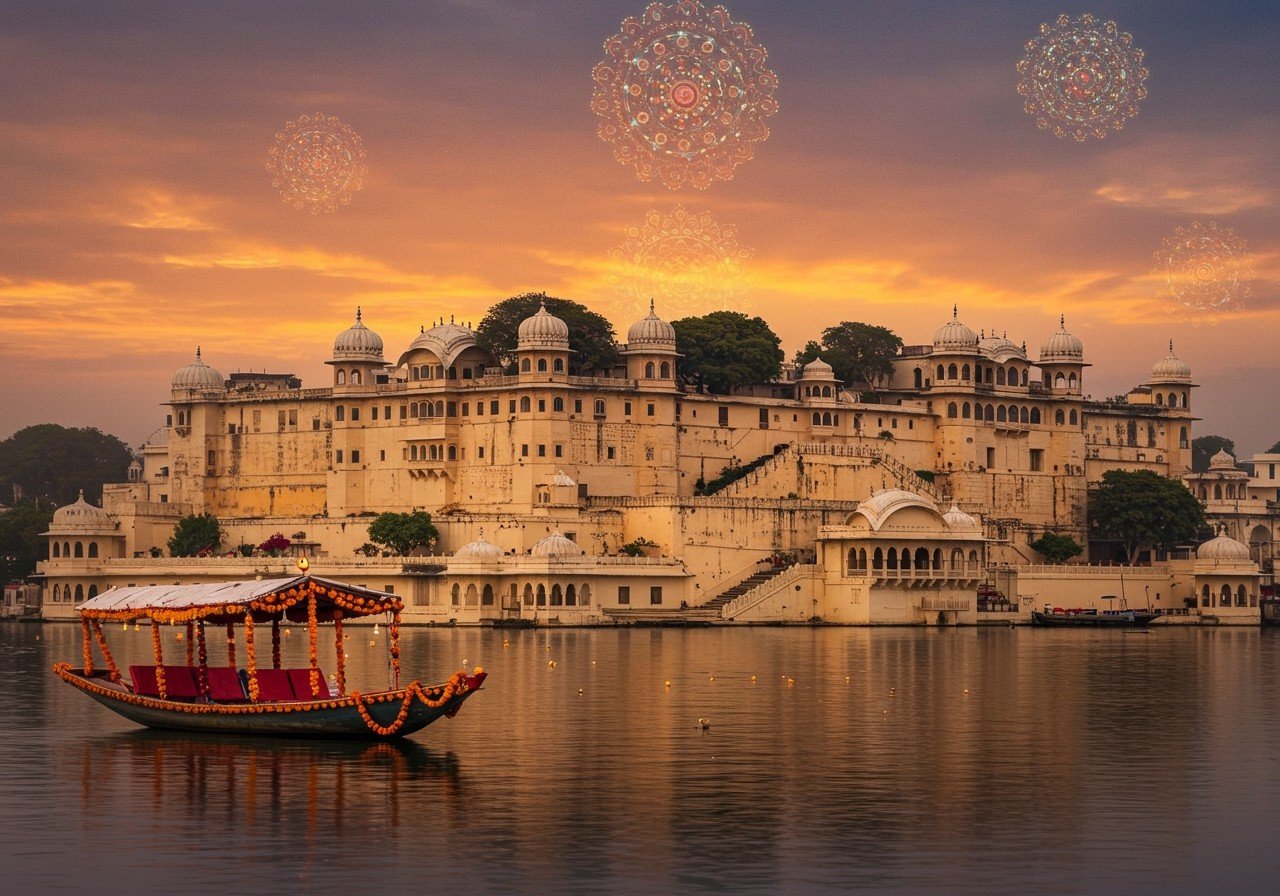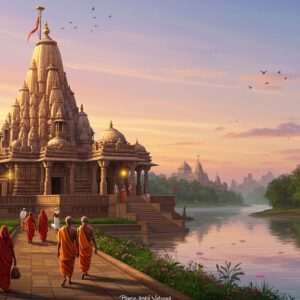
Udaipur, the “City of Lakes,” nestled in the Aravalli hills of Rajasthan, is more than just a picturesque destination. It’s a place where history and spirituality intertwine, offering a captivating journey for the soul. Beyond the grandeur of the City Palace, Udaipur unveils a treasure trove of architectural wonders, havelis whispering stories of the past, and temples that echo with devotion. Let’s embark on an exploration of these hidden gems, where craftsmanship meets divine grace.
Unveiling Udaipur’s Architectural Gems
Venture beyond the well-trodden path and discover the architectural marvels that lie hidden in Udaipur’s heart. Bagore Ki Haveli, a magnificent mansion, offers a glimpse into the royal lifestyle of the Mewar dynasty. Its intricate mirror work and vibrant frescoes speak of a bygone era of elegance and artistry. The Ahar Cenotaphs, sculpted from marble and sandstone, stand as timeless memorials, each narrating a chapter of the region’s rich history. And as you wander through the charming streets around Jagdish Temple, the havelis, with their ornate balconies and intricately carved facades, whisper tales of Rajput and Mughal architectural influences, a harmonious blend of cultures.
These structures are not merely architectural wonders; they are living testaments to traditional art forms, housing local artisans and their workshops, keeping alive the flame of craftsmanship passed down through generations. Many of these historical buildings have been transformed into museums and cultural centers, playing a vital role in promoting tourism and education, ensuring that the stories of the past continue to inspire the present.
- City Palace: Witness the grandeur of the largest palace complex in Rajasthan, a blend of Rajput, Mughal, European, and Chinese architectural styles, perched majestically on the banks of Lake Pichola. Started in 1553 by Maharana Udai Singh II, its intricate carvings, jharokhas, and courtyards speak volumes about the rich history and resilience of the Mewar dynasty. The palace’s construction followed the fall of Chittorgarh to the Mughals in 1559, marking a new chapter in Mewar’s history.
- Jagdish Temple: This 17th-century temple dedicated to Lord Vishnu is a spiritual oasis. Its intricate carvings and serene ambiance invite contemplation and reverence. The temple stands as a testament to the devotion of the Mewar rulers and the skill of the artisans who brought it to life. It is a vibrant center of worship and a focal point for cultural activities, bringing the community together in celebration and prayer.
The Divine Craftsmanship of Udaipur’s Temples
Udaipur’s temples are not just places of worship; they are architectural masterpieces that embody the deep-rooted spirituality of the region. Jagdish Temple, an iconic landmark, showcases the Indo-Aryan style in all its glory, with intricate carvings that depict mythological tales, transporting you to a realm of gods and goddesses. The use of local marble and sandstone not only adds to the aesthetic appeal but also ensures the longevity of these sacred structures. Every detail, from the towering spires to the innermost sanctums, reflects the devotion and unmatched skill of the artisans who poured their hearts into creating these divine abodes.
Temples like Eklingji, dedicated to Lord Shiva, are unique in their blend of Hindu and Jain architectural elements, a testament to the harmonious coexistence of different faiths in the region. These temples serve as vibrant centers of cultural and religious activities, hosting festivals and community gatherings, weaving the spiritual fabric of Udaipur’s society. Each architectural element holds deeper philosophical meanings, inviting devotees and visitors alike to delve into the rich tapestry of Hindu beliefs.
Dive deeper into the divine with our blog post on Aadi Himani Chamunda.
The Sacred Waters of Udaipur: A Symphony of Nature and Architecture
Water, a symbol of life and purity, plays a central role in Udaipur’s architectural heritage. The shimmering lakes, like the iconic Lake Pichola and the tranquil Fateh Sagar Lake, are not just picturesque backdrops but integral parts of the city’s identity. They provide sustenance, enhance the city’s beauty, and offer serene settings for meditation and reflection, nurturing the spiritual well-being of the people. Stepwells, such as the magnificent Neemach Mata Stepwell, showcase the ingenuity of ancient water management systems, serving as vital water sources in the arid climate while also serving as communal spaces, fostering a sense of community and shared purpose.
These water bodies stand as testaments to the vision of the Maharanas of Mewar, who prioritized sustainable water management. Their architectural features seamlessly blend functionality with artistry, reflecting a deep respect for nature. The cultural activities centered around these water bodies celebrate Udaipur’s inseparable connection with the natural world. Even amidst the challenges of urbanization, efforts continue to preserve these ancient structures, ensuring that future generations can inherit the legacy of environmental stewardship.
Explore more about sacred sites and temples in our dedicated blog post.
Enhancing Your Spiritual Journey with Poojn.in
As you immerse yourself in the spiritual aura of Udaipur, enhance your experience with authentic puja items from Poojn.in, India’s leading online store for cultural and religious products. We offer a wide range of high-quality items to enrich your pujas and spiritual practices.
One of our featured products is the 100% Pure Arjun Chal Powder, known for its purity and traditional significance. Whether you need it for personal use or for larger ceremonies, we offer convenient packaging options in 100 gm, 250 gm, and 1 kg quantities, ranging from ₹169.00 to ₹369.00. Order online from the comfort of your home and have these essential items delivered right to your doorstep.
For bulk orders or wholesale inquiries, connect with us on WhatsApp at 9476142738. Our dedicated customer support team is always available to assist you at 03369029784.
Discover the sacred Alta Pata and other puja essentials on Poojn.in.
Embracing Udaipur’s Timeless Heritage
Udaipur’s architectural marvels are not just structures of stone and marble; they are living embodiments of a rich and diverse heritage. From the majestic palaces to the serene temples, and from the tranquil lakes to the ingenious stepwells, each element whispers a unique story, inviting you to connect with the soul of Udaipur. As you explore these wonders, you embark on a journey through time, celebrating the living traditions that continue to thrive amidst modernity. Allow Udaipur’s architectural legacy to inspire you to preserve and appreciate the cultural tapestry that makes this city so extraordinary.
Frequently Asked Questions About Udaipur’s Architectural Marvels
Many travelers wonder about the hidden gems and the stories behind Udaipur’s architectural wonders. Here are some common questions answered:
What are some lesser-known historical structures and havelis in Udaipur besides the City Palace? While the City Palace is undoubtedly magnificent, Udaipur has many hidden treasures waiting to be discovered. Bagore Ki Haveli, with its stunning mirror work, and the Ahar Cenotaphs, a complex of royal tombs, offer a glimpse into the rich history and architectural styles of the Mewar dynasty. Exploring these lesser-known sites provides a deeper understanding of Udaipur’s layered past.
How do Udaipur’s temples reflect the city’s deep-rooted craftsmanship and devotion? The temples of Udaipur, such as the iconic Jagdish Temple and the serene Eklingji Temple, are not merely structures of worship; they are expressions of artistic devotion. The intricate carvings, detailed sculptures, and the use of locally sourced marble and sandstone showcase the exquisite craftsmanship and the profound spiritual significance embedded in every detail. These temples serve as vibrant centers of faith and cultural expression.
What is the significance of stepwells and lakes in Udaipur’s history and culture? Stepwells and lakes are integral to Udaipur’s identity, reflecting its historical ingenuity in water management and its deep connection with nature. Stepwells like Neemach Mata Stepwell served as essential water sources while also becoming social hubs. Lakes like Lake Pichola and Fateh Sagar Lake enhance the city’s beauty and offer serene spaces for reflection, enriching the spiritual and cultural life of the community.
What is the best way to explore Udaipur’s architectural marvels? To fully appreciate the richness of Udaipur’s architectural heritage, consider guided tours or walking tours that delve into the history and significance of each site. These tours offer valuable insights and context, enhancing your understanding and appreciation of the city’s architectural treasures.
Why is Udaipur considered a blend of history and spirituality? Udaipur’s unique blend of history and spirituality is woven into the fabric of its palaces, havelis, temples, and water bodies. The city’s rich past, marked by the reign of the Mewar dynasty, intertwines seamlessly with the spiritual reverence reflected in its temples and the serene natural landscapes, creating an atmosphere of tranquility and cultural depth.
Are there any festivals that showcase Udaipur’s architectural beauty? Yes, festivals like the Mewar Festival and Diwali offer a spectacular display of Udaipur’s architectural beauty. During these celebrations, the city’s structures are illuminated with lights and decorations, creating a magical ambiance that enhances their architectural splendor.
What sets Udaipur’s architectural style apart from other cities? Udaipur’s architectural style is a harmonious fusion of Rajput and Mughal influences, distinguished by intricate details and the extensive use of marble. The craftsmanship is evident in the ornate carvings, delicate jharokhas, and grand courtyards, creating a visual symphony that sets it apart from other architectural styles.


